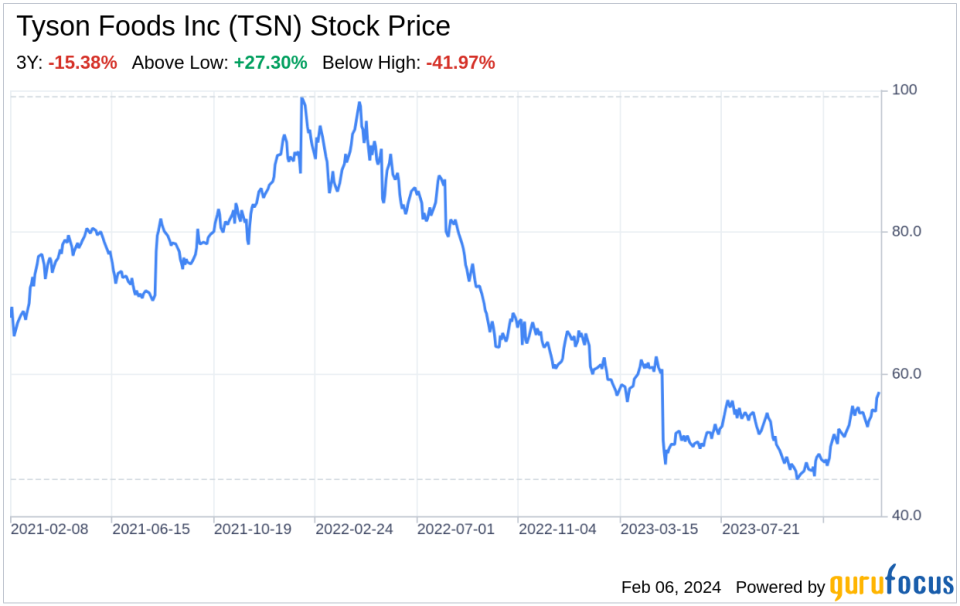Decoding Tyson Foods Inc (TSN): A Strategic SWOT Insight
Comprehensive SWOT analysis based on Tyson Foods Inc's latest 10-Q filing.
Financial overview reveals a slight increase in sales but a significant drop in net income.
Strategic evaluation of Tyson Foods Inc's market position and future prospects.
Detailed examination of Tyson Foods Inc's operational and market challenges.
On February 5, 2024, Tyson Foods Inc (NYSE:TSN), a leading protein-focused food producer, filed its 10-Q report, providing a snapshot of its financial performance and operational dynamics. The company, known for its extensive range of products including raw and prepared foods, reported a marginal increase in sales from $13,260 million to $13,319 million for the three months ended December 30, 2023. However, the net income attributable to Tyson showed a stark decline from $316 million to $107 million, reflecting a challenging operating environment. This SWOT analysis delves into the strengths, weaknesses, opportunities, and threats as presented in the filing, offering investors a nuanced understanding of Tyson Foods Inc's strategic positioning.

Strengths
Brand Portfolio and Market Presence: Tyson Foods Inc (NYSE:TSN) boasts a robust portfolio of well-established brands such as Tyson, Jimmy Dean, Hillshire Farm, Ball Park, and Sara Lee. These brands have secured a significant presence in the U.S. market, particularly in the beef and chicken segments, which each account for about one-third of domestic sales. The company's Prepared Foods segment, representing approximately 20% of sales, benefits from a diverse product range that caters to various consumer preferences. Tyson's brand strength is underpinned by its ability to maintain and grow customer relationships, introduce innovative products, and leverage its scale to achieve operational efficiencies.
Operational Scale and Diversification: Tyson Foods Inc's large-scale operations provide a competitive edge in terms of cost efficiency and market reach. The company's diversified product offerings across beef, pork, chicken, and prepared foods allow it to mitigate risks associated with market volatility in individual segments. Tyson's extensive distribution network, including international markets that contribute 5% of total revenue, enhances its ability to serve a global customer base and capitalize on cross-border growth opportunities.
Weaknesses
Financial Performance Volatility: The recent 10-Q filing reveals a concerning drop in net income attributable to Tyson, which plummeted from $316 million to $107 million year-over-year. This decline reflects the volatility in financial performance that Tyson Foods Inc faces, driven by fluctuating commodity prices, supply chain disruptions, and competitive pressures. The company's cost of sales increased from $12,292 million to $12,496 million, outpacing sales growth and squeezing gross profit margins from $968 million to $823 million. Such financial volatility can impact investor confidence and the company's ability to invest in growth initiatives.
Legal and Operational Challenges: Tyson Foods Inc's operational income was adversely affected by significant charges, including $75 million in plant closure charges, $73 million in legal contingency accruals, and $30 million of restructuring and related charges. These challenges highlight the company's exposure to legal risks and the costs associated with maintaining operational efficiency. The need to navigate complex regulatory environments and manage legal disputes can divert resources from strategic growth areas and impact the bottom line.
Opportunities
International Expansion: While Tyson Foods Inc currently generates a modest 5% of its total revenue from international markets, there is significant room for growth in regions with increasing protein demand. The company's existing presence in key markets such as Australia, China, Malaysia, Mexico, and others provides a foundation for scaling operations and capturing market share. By leveraging its brand strength and operational expertise, Tyson can tap into emerging markets, where rising incomes and changing dietary preferences favor increased protein consumption.
Innovation and Product Development: Consumer trends toward convenience, health, and sustainability present opportunities for Tyson Foods Inc to innovate and expand its product offerings. The company's focus on prepared foods, including ready-to-eat and value-added products, aligns with the shift towards convenient meal solutions. Continued investment in product development, particularly in plant-based protein alternatives, can help Tyson meet evolving consumer demands and drive long-term growth.
Threats
Market Competition and Price Sensitivity: Tyson Foods Inc operates in highly competitive segments where it does not always hold a significant market share lead. Intense competition from both established players and new entrants can lead to price wars, eroding margins and market position. The company must continuously innovate and differentiate its products to maintain consumer loyalty and pricing power in a market characterized by price sensitivity and low switching costs.
Supply Chain and Commodity Risks: The company's reliance on live cattle and hogs, raw materials, and feed ingredients exposes it to supply chain vulnerabilities and commodity price fluctuations. Adverse weather conditions, disease outbreaks, and geopolitical tensions can disrupt supply chains and lead to cost increases. Tyson Foods Inc must navigate these risks through strategic sourcing, hedging, and supply chain management practices to ensure stability and profitability.
In conclusion, Tyson Foods Inc (NYSE:TSN) exhibits a strong brand portfolio and operational scale that position it well in the protein-focused food industry. However, the company faces challenges in terms of financial performance volatility and legal contingencies that could impact its growth trajectory. Opportunities for international expansion and product innovation present pathways to enhance market share and revenue. Nevertheless, Tyson must strategically manage threats from market competition and supply chain risks to sustain its competitive advantage and deliver value to shareholders.
This article, generated by GuruFocus, is designed to provide general insights and is not tailored financial advice. Our commentary is rooted in historical data and analyst projections, utilizing an impartial methodology, and is not intended to serve as specific investment guidance. It does not formulate a recommendation to purchase or divest any stock and does not consider individual investment objectives or financial circumstances. Our objective is to deliver long-term, fundamental data-driven analysis. Be aware that our analysis might not incorporate the most recent, price-sensitive company announcements or qualitative information. GuruFocus holds no position in the stocks mentioned herein.
This article first appeared on GuruFocus.
